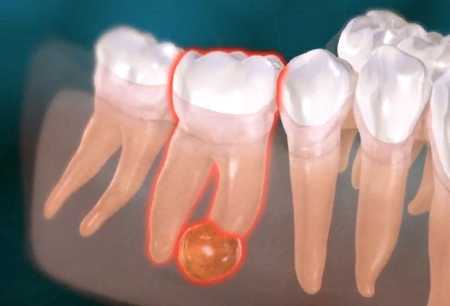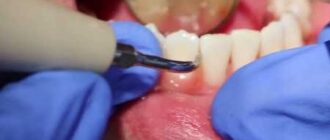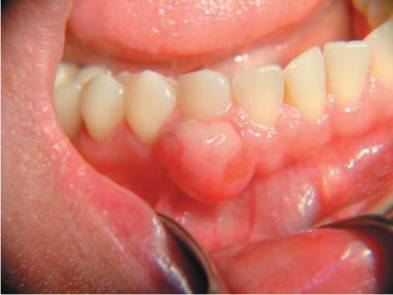A tooth cyst is a signal that the destruction of living tissue in the oral cavity is in full swing. If a patient ignored preventive examinations and went to the doctor only when pain appeared, the neoplasm has already reached serious size. It has to be removed surgically.
In the early stages the danger can be neutralized without surgery – with conservative methods of treatment. But to do this, you need to know what a cyst is, how it arises and develops.
Cyst Development
If an infection enters the bone tissue of the tooth, it begins to break down. The traumatized cells die off, and a cavity appears in their place. The body struggles to resist the inflammation and builds a protective film around it, a barrier that prevents the infection from spreading further. The cavity at the apex of the tooth root, surrounded by a thick shell, is a cyst. Inside it is filled with exudate – bacteria, secretions from blood vessels with a high leukocyte count, and dead bone cells. Unfortunately, even under the shell, the cyst continues to grow. Inflammation seems to undermine the bone from the inside, and if no action is taken, there will simply be no bone left under the tooth.
The bone cavity can be of any size. The longer the infection is in the bone, the larger the cyst grows. The neoplasm develops in 3 stages. This division is relative. The stages of cyst development are determined by its size and tracked on the radiograph, but only a histologist can determine them reliably.
The first stage is a granuloma. It grows on the root of the tooth quite quickly, and its diameter does not exceed 5 mm. The next stage is a cystogranuloma. This formation is not cavitary, without exudate, but already surrounded by the shell characteristic of a cyst. It does not exceed 8 mm in diameter. The final stage of the disease is a cyst, which is a cavity of more than 9 mm. The last 2 phases are irreversible without surgical treatment.
Causes
Cysts on the apex of the tooth – the result of inflammation that has passed into the chronic stage. There are known cases of their degeneration into malignant tumors.
Even a small inflammatory process in the oral cavity can lead to damage to the bone and the formation of a cavity in it.
Affects the formation of cysts and the general state of the body. More often cysts form in women over the age of 45.
The main reason for the appearance of granulomas and cysts is poor quality or untimely treatment of dental caries. And it can be avoided only by turning to a doctor in time.
How Dangerous is a Tooth Cyst
Cysts and granulomas are dangerous because they progress unnoticed. The condition begins to worsen when the neoplasms reach a critical size. Your body becomes increasingly intoxicated, and with it comes fatigue, weakness, headaches, and frequent temperature changes. When the cyst “eats away” the bone around the tooth, and from it remains only a thin plate, the symptom of a parchment-like crunch occurs. The inflammation then spreads even deeper into the mouth, causing the jaw to fracture. If the immune system is compromised, the tumor can fester.
But don’t think that festering cysts are more dangerous than normal cysts. The level of intoxication of the body in both cases is equally high. Any cyst is subject to immediate removal.
There is also the danger of fusion of the cyst with the mandibular nerve, its protrusion into the nasal cavity or maxillary sinus, or its spread to the neighboring teeth. The listed circumstances complicate the process of removing the mass and the recovery period after surgery.
Diagnosis
While the cyst is small, it does not manifest itself in any way. There is no pain in the mouth. At most, the color of the tooth changes, and while biting hard food there is an unpleasant sensation. But even these are not necessary.
Discomfort appears later, when the cyst reaches a significant size. It begins to feel like the teeth are shifting somewhere. When you try to palpate the deformed area, a sound similar to the crunching of parchment appears. To the touch, the walls of the mass feel so dense and stretched that your fingers spring back like an elastic band.
Diagnosis of a cyst in its early stages can only be made by X-ray imaging. That is why it is so important to see a dentist every six months. At the slightest suspicion of a neoplasm, he will send you for an X-ray. If there is a risk that the cyst is malignant, the doctor will do a puncture and take the shell of the mass for histological examination when removing it.
Tooth Cyst Treatment Methods
Many patients believe that the treatment of a tooth root cyst will necessarily be accompanied by removal of the tooth. In fact, it is carried out only in extreme cases, and modern methods of treatment of a tooth cyst involve its preservation and minimal tissue trauma. The only exception is wisdom tooth cysts, as they are usually not treatable.
When it is possible to access the cyst through an unsealed root canal, and the size of the neoplasm does not exceed 7-8 millimeters, therapeutic treatment methods are used. If complicated cases are involved, such as a mass between the teeth and in the deeper gum tissue, or anterior tooth cysts, treatment is surgical. See the table below for more information about cure methods for tooth cysts.
Therapeutic Methods for Treating a Tooth Cyst
Medication disinfection
The procedure is the pumping out of its cavity of liquid or pus and the introduction of drugs that promote the formation of new bone tissue into the cyst. This is followed by antiseptic treatment and filling the root canal. This method is also used for granulomas. Unfortunately, in the case of a tooth root cyst, the treatment with this method does not always give 100% results – sometimes there are relapses.
Copper-calcium suspension
The doctor inserts a copper-calcium suspension into the root canal, which penetrates into the cyst bubble, and then uses special equipment to apply a low-power electrical current to the neoplasm. The result is comparable to that of medical treatment.
Laser treatment
A modern, minimally invasive, but the most expensive method. Cysts under the crown of the tooth, the most effective treatment of which is laser, is easily removed using this method. The laser beam not only fights the neoplasm itself, but also disinfects the surrounding tissue. Treatment of cysts under the crown of the tooth is also performed through an open root canal, where the doctor inserts a microscopic source of laser radiation. After the procedure, the wound heals quickly and without complications. In this way it is possible to save the tooth and the tissues around it as much as possible.
Surgical Treatment of Cysts of the Tooth
Cystectomy
The most progressive and effective method of treating anterior tooth cysts. Treatment under a microscope, using special equipment, allows you to save as much healthy tissue as possible. Under local anesthesia, the doctor completely removes the neoplasm of any size, while preserving as much healthy tissue as possible. During treatment of a tooth root cyst, the surgeon opens the cyst, cleans the tissue of infection, injects antiseptic and sews up the gum. The surgery lasts 15 to 40 minutes, and after another hour, the patient can go home. The cavity in the gum will eventually grow back into bone tissue.
Cystotomy
This method is used in complicated cases, when the bone tissue has become too thin, and the cyst itself has reached a large size and has spread over 2 to 3 teeth. The doctor removes only the front part of the cyst, leaving its cavity open, and installs an obturator, which, for a period of time, prevents the cystic tissue from growing back together. In this way, the affected tissues change their structure and become non-hazardous during the long-term recovery process.
Hemisection
This operation is considered the most traumatic, although quite simple. The surgeon makes an incision, removes the neoplasm together with the root or its separate fragment, as well as part of the crown, and sews up the wound. Often an orthopedic structure is used to fill the cavity. Recovery from surgery usually takes up to 3 days.






